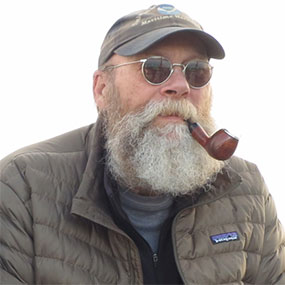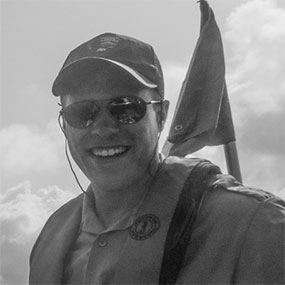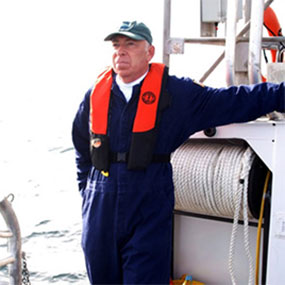

NOAA Office of National Marine Sanctuaries Maritime Heritage Program – Bear Mission Coordinator
For more than four decades, Brad Barr has been actively engaged as a practitioner in the governmental side of marine and coastal protected areas management and preservation. He received his undergraduate and graduate degrees at the Universities of Maine and Massachusetts and his PhD from the University of Alaska Fairbanks. He is currently a Senior Advisor in the Office of National Marine Sanctuaries’ Maritime Heritage Program. For the past 12 years, he has served as Visiting Faculty at the University Center of the Westfjords in Ísafjör∂ur, Iceland, teaching courses on marine protected areas, preservation of underwater cultural heritage resources, and Arctic Ocean governance. He is also an Affiliate Professor at the University of New Hampshire School of Marine Science and Ocean Engineering and has taught graduate courses at the World Maritime University in Malmö, Sweden. He is a member of the International Union for Conservation of Nature (IUCN) World Commission on Protected Areas, serves on the IUCN Marine Mammal Protected Areas Task Force, and is a founding member of the International Committee on Marine Mammal Protected Areas. He has served on the Boards of Directors of the George Wright Society in the United States, as well as the Science and Management of Protected Areas Association (SAMPAA) and the Coastal Zone Canada Association (CZCA) in Canada. He was awarded a “Partners for the Americas” Fellowship, conducted in British Colombia, focused on effective Indigenous co-management of protected areas, and more recently, a Fulbright Research Fellowship to characterize and make recommendations regarding the preservation of the whaling heritage landscape of Iceland. He has also been Chief Scientist and Co-Principal Investigator of a 2015 research expedition to the Arctic, including a mission to map and document whaling shipwrecks in the nearshore waters of the Chukchi Sea. He has published extensively on research focused on marine protected areas science and management, the identification and management of ocean wilderness, and place-based whaling heritage preservation.

CSA Ocean Sciences Inc. – Operations Supervisor
John Bright is a Maritime Archaeologist with an extensive background in geophysical survey operations, applied GIS, and archaeological remote sensing survey techniques. He holds a BS in Biology from East Carolina University and an MA from the East Carolina University Program in Maritime Studies. John worked as an archeologist for the U.S. National Park Service’s Submerged Resources Center before serving as the Research Coordinator at the NOAA Thunder Bay National Marine Sanctuary in Alpena, Michigan. Currently, he works as an Operations Supervisor and Cultural Resources Specialist with CSA Ocean Sciences. In this role, John supports cultural resource and environmental surveys worldwide, utilizing an array of tools and technology to conduct offshore marine science and resource investigations.

U.S. Coast Guard – Assistant Historian
Beth Crumley has served as the Assistant Historian of the U.S. Coast Guard since October 2017. Prior to joining the Coast Guard Historian’s Office, Ms. Crumley served as a Reference Historian at Marine Corps History Division and as an ordnance curator at the National Museum of the Marine Corps, where she was a member of team that planned and opened the museum in 2006.
She is the author of Coast Guard Compass blogs on the loss of U.S. Coast Guard Cutters Jackson and Bedloe, written after participating in a NOAA expedition to map wrecks off the North Carolina coast, and a blog on aviation pioneer Frank A. Erickson. Ms. Crumley also authored USMC: Three Centuries of Glory, and edited A Legacy Walk through Marine Corps and USMC: A Complete History. She has written numerous articles that have appeared in “Fortitudine,” “Leatherneck,” “Proceedings,” and “International Committee of Museum of Arms and Military History. In addition, Ms. Crumley wrote a weekly history blog for the Marine Corps Association.
Ms. Crumley has delivered lectures on U.S. Coast Guard history to include the loss of Escanaba in World WAr II; Medal of Honor recipient Douglas Munro; the genesis of U.S. Coast Guard helicopter aviation; and Frank Erickson: Aviation pioneer, presented at Erickson’s posthumous Legion of Merit ceremony at Coast Guard Headquarters. Over the course of her career, she has presented several papers at the Society for Military History and the McMullen Naval Symposium and lectured at the National Museum of the Marine Corps, the Pentagon, Marine Corps Officer Candidate School, Marine Corps Systems Command, the Freedom Foundation, and U.S. Coast Guard Headquarters. While serving as the unit historian at Marine Corps History Division, Ms. Crumley presented lectures to several Marine Corps units and veteran’s groups and conducted tours of the World War I battlefield at Belleau Wood. She was also a participant in panel discussions at Marine Corps Aviation Association conference and spoke on early Coast Guard helicopter aviation at the Vertical Flight Society conference.
She has been featured as a subject matter expert on television’s “Weaponology,” “Lock n’ Load,” and “American Rifleman.” Additionally, she has been nominated for the Marine Corps Heritage Foundation’s Wallace Greene Award and twice-nominated for the Heinl Award for excellence in journalism.

NOAA Office of National Marine Sanctuaries Maritime Heritage Program – Mission Principal Investigator and Chief Archaeologist
Joe Hoyt is a maritime archaeologist with NOAA's Office of National Marine Sanctuaries. He specializes in archaeological recording of deepwater shipwrecks and has worked on several NOAA projects in the Thunder Bay, Florida Keys, and Monitor National Marine Sanctuaries since 2001. In 2004, he was awarded the North American Rolex Scholarship through the Our World Underwater Scholarship Society. He has worked on underwater archaeology projects in North and South America, Europe, the Great Lakes, Atlantic and Pacific Oceans, and several inland rivers. Joe is also an avid underwater photographer and technical diver and has crewed documentary expeditions on BBC's Planet Earth and PBS. For the last 10 years, Hoyt has been the Chief Scientist on a multifaceted wide-area investigation of World War II-era shipwrecks lost off the coast of North Carolina. In 2014, Hoyt led a team of researchers that discovered the final resting place of a World War II Battlefield off the coast of North Carolina, consisting a German U-boat, U-576, and its victim, a Nicaraguan flagged freighter, Bluefields. Hoyt earned an MA in Maritime History and Nautical Archaeology from East Carolina University and serves on the Advisory Council for Underwater Archaeology.

Maritime Studies Department, East Carolina University – Graduate Student
Tyler McLellan is a second year graduate student in the Maritime Studies Department at East Carolina University. His main area of interest is on the Battle of the Atlantic off of the coast of North Carolina, and he is also working to acquire various technical skill sets such as in Geographic Information Systems. Tyler has worked at a fur trade site in northern Alberta; studied the Mayan temples in Guatemala; excavated at a Lucayan site on San Salvador Island, Bahamas; studied at Minoan sites on Crete, Greece; and studied at various sites in North Carolina, including the Greenville Lock on the Tar River. He has conducted transcription work for the Youngstown Steel Museum of Industry and Labor as well as the Bedford Historical Society and conducted lab work for Youngstown State University's Anthropology Department. Tyler is certified as an AAUS Scientific Diver and hopes to attain the rank of Dive Master as well as technical diver. In his free time, he enjoys being outdoors.

Mike Overfield headed back to sea for a research expedition aboard the U.S. Navy Nuclear Research Submarine NR-1. Image courtesy of David Alberg, NOAA, 2006.
(1955-2009)
NOAA Office of National Marine Sanctuaries Maritime Heritage Program – Maritime Archaeologist
While Mike is no longer with us, his legacy lives on in the “Hunt for the Bear.” During his time with NOAA’s Maritime Heritage Program, Mike was the creative force behind many fascinating projects, and this one was no exception. His curiosity was as boundless as his energy and enthusiasm, and the Bear was on the top of his list of projects we needed to pursue. His original research on the Bear is being used to inform and guide planning, and his skills and expertise as a talented maritime archaeologist provide us with the foundation for the seabed mapping survey design we are using on this mission. While Mike may not be physically present onboard the U.S. Coast Guard Cutter Bear, his spirit is a light that still shines brightly on that patch of ocean we are mapping, illuminating the darkness we are exploring. We are grateful and humbled to have the opportunity to, once again, honor Mike’s legacy with this mission to find the last resting place of yet another bright light in the rich and compelling maritime history of the United States.

U.S. Coast Guard – Atlantic Area Historian
Dr. Thiesen serves as Atlantic Area Historian for the U.S. Coast Guard. Prior to working for the Coast Guard, he taught history at the undergraduate and graduate levels and served as curator and assistant director for five years at the Wisconsin Maritime Museum, the largest maritime museum on the Great Lakes. Dr. Thiesen earned a master’s degree from East Carolina University’s Program in Maritime History, with a concentration in naval history, and a Ph.D. in University of Delaware’s Hagley Program in the History of Industrialization and Technology, with a specialization in maritime industries and technology. His articles and reviews have appeared in numerous naval and maritime journals, including Proceedings of the United States Naval Institute, Naval History Magazine, Naval War College Review, International Journal of Maritime History, The Mariner’s Mirror, Sea History Magazine, Nautical Research Journal, The American Neptune, and the Journal of Maritime Research. His books include Industrializing American Shipbuilding: The Transformation of Ship Design and Construction, 1820-1920 and Cruise of the Dashing Wave: Rounding Cape Horn in 1860. Thiesen’s Coast Guard-history series, “The Long Blue Line,” is featured weekly on the Coast Guard Compass website.